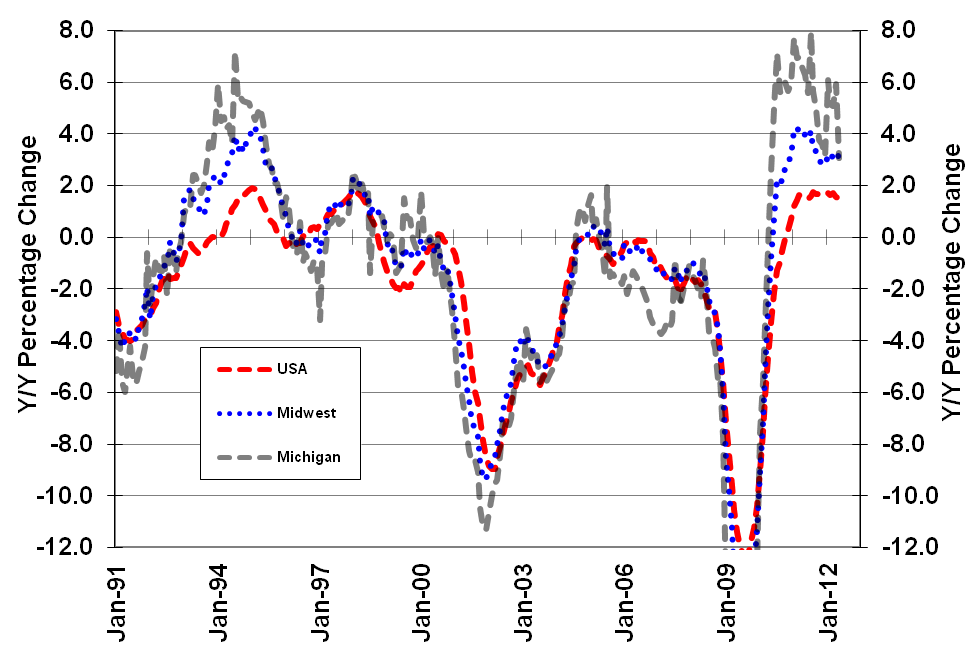First-Half Seventh District Manufacturing Performance
While manufacturing activity has been slowing over the past couple of months, its performance over the first half of 2012 would definitely be scored as a positive for the region. Seventh District manufacturing activity built on its momentum from last year and continued to grow through the first half of 2012. Growth occurred at rates fast enough to virtually eliminate the output deficit that the Seventh District had developed relative to the U.S. during the Great Recession. Chart 1 shows the performance of the Federal Reserve Bank of Chicago’s Midwest Manufacturing Index versus the Federal Reserve System’s Manufacturing Production Index, which is part of its Industrial Production release. The Seventh District’s output deficit narrowed quickly in the early months of 2012, as growth in the Midwest manufacturing sector accelerated.
1: Chicago Fed Midwest Manufacturing Index vs. U.S. Manufacturing Production Index

In an earlier blog, I noted that, based on purchasing managers’ index (PMI) reports throughout the Seventh District, manufacturing was expanding at a faster rate in the Midwest than in the U.S., most likely leading to faster economic growth for the region than the U.S. as a whole during last year and into this year. Over the first half of 2012, PMI reports for the Seventh District indicate this trend is continuing. However, recent individual PMI reports suggest the nationwide slowing of manufacturing has spread into some parts of the Seventh District.
Chart 2 shows PMI readings from Seventh District locations since the beginning of 2011.1 Since January 2012, manufacturing activity in Iowa and Southeast Michigan (metro Detroit) has continued to expand at a fairly steady pace. Meanwhile, Western Michigan, and Milwaukee have seen some slowing in the rate of increase in manufacturing activity—especially in Western Michigan, where office furniture production has slowed somewhat due to a softening expansion in U.S. business fixed investment spending and automotive suppliers have slowed production because of increasing national and global economic uncertainty.
2: U.S. and Seventh District PMIs: Total

Despite an overall slowing of the pace of growth in some areas, manufacturers continue to add modestly to their payroll employment. Indeed, according to PMI reports, employment gains have accelerated in Chicago and Southeast Michigan. Using data on payroll employment from the Bureau of Labor Statistics, Chart 3 compares manufacturing employment growth rates in the U.S., Seventh District, and Michigan. Manufacturing employment has grown at faster rates in the District thus far in 2012, and especially in Michigan, than in the nation, thanks in large part to a rebound in auto-related production, spurred by rising national demand for light vehicles.
3: U.S., Seventh District, Michigan Employment: Year/Year Change in Manufacturing Employment Growth

However, employment gains haven’t been limited to auto-related manufacturing sectors. Chart 4 compares job growth in manufacturing sectors excluding auto-related manufacturing. Other manufacturing sectors in the Seventh District and Michigan have also added jobs at faster rates than the U.S. Agriculture continues to be a boon for the Seventh District economy, translating into job growth in food manufacturing and machinery. Employment levels among Seventh District food manufacturers are 1.8% higher than a year ago, compared with just 0.4% growth nationally. In Iowa, food manufacturing employment has grown 2.2% over the last year. Iowa has also seen robust hiring from machinery manufacturers, specifically agriculture, construction, and mining machinery. Machinery sector employment in Iowa has increased 16% from the previous year.
4: U.S., Seventh District, Michigan Employment: Year/Year Change in Manufacturing Employment Growth Excluding Autos

The District has recorded significant employment growth in agriculture, machinery, printing, plastic, rubber, metal, and furniture-related industries. With improving employment and output growth across such a wide range of sectors, the region continues to outperform the nation to a modest degree.
Footnotes
1 These PMI readings have been smoothed with a 12-month moving average as they are not seasonally adjusted (so that all locations can be compared).








